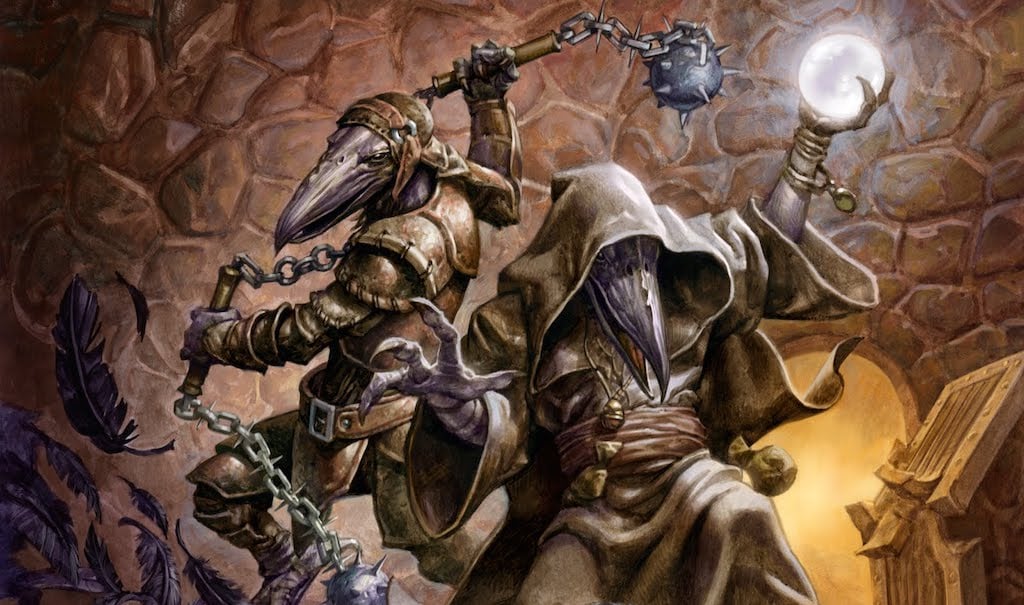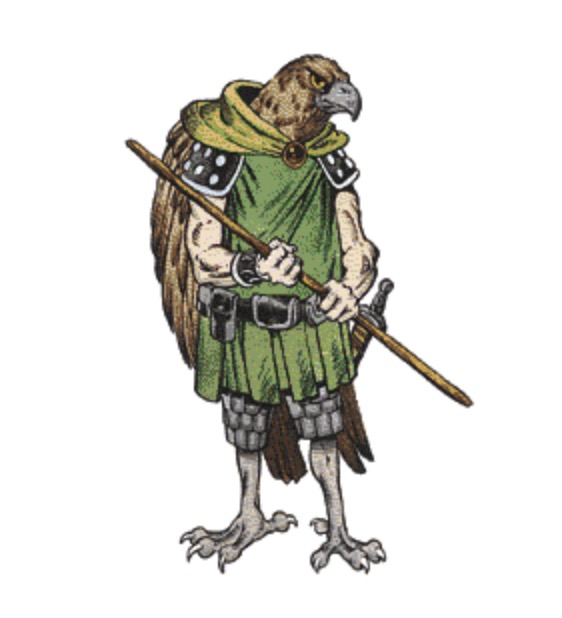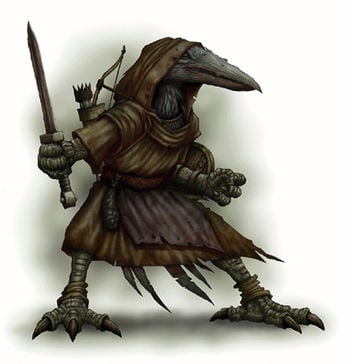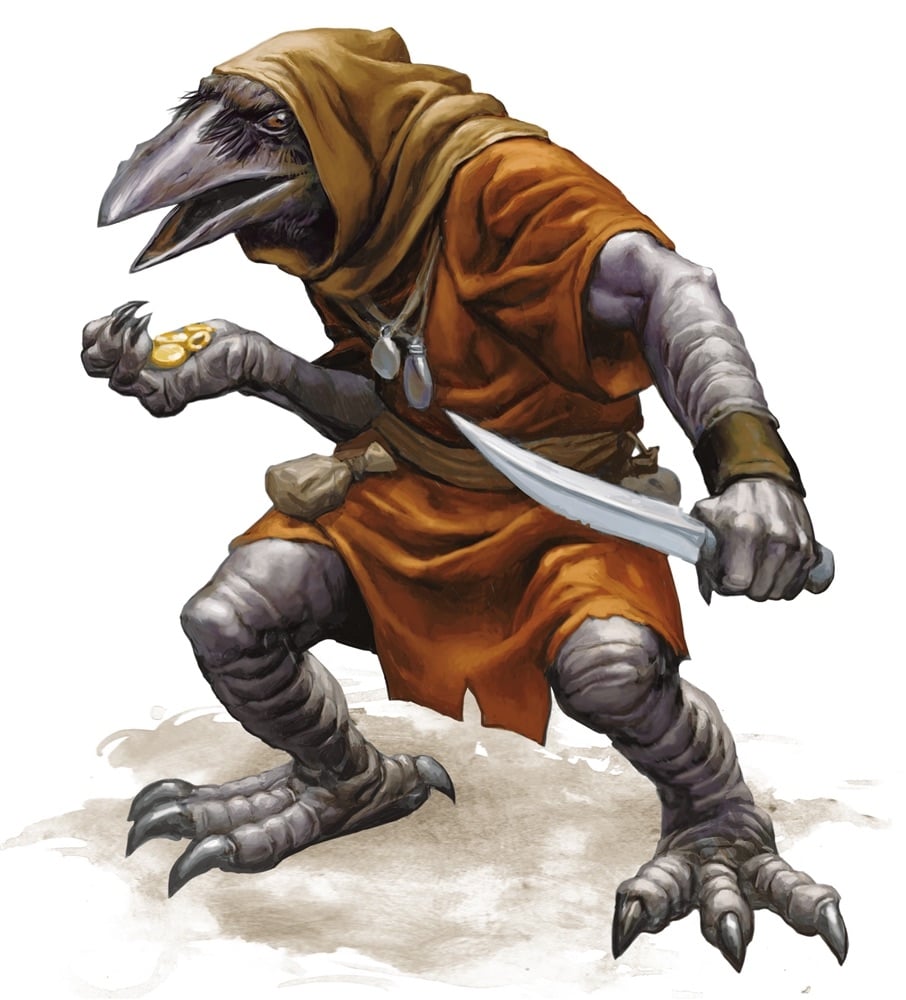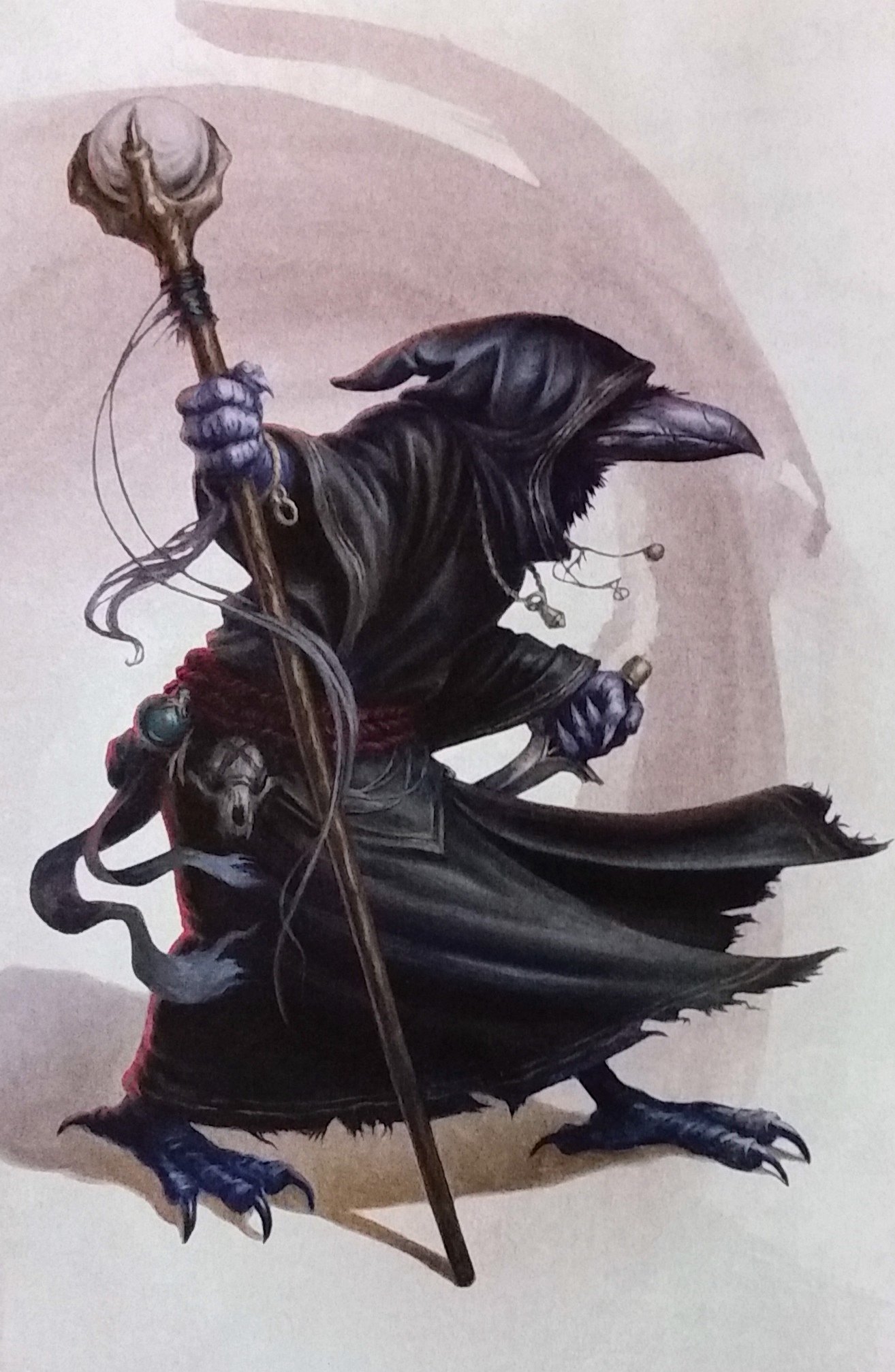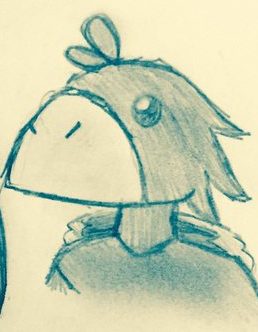D&D Monster Spotlight: Kenku


This week’s monster is a birdman–or is it a manbird? Only one way to be sure.
What makes a monster a monster? Is it simply an appearance in the Monster Manual? If so, Man was the real monster all along.
But it’s clearly more than that. Maybe it’s the frequency with which player characters have to face them? Although again that makes humanity among the biggest contenders for monsters (which I guess means they should get their own article here in a while). The reason I bring up these points is: this week’s monster began as a monster way back in the Fiend Folio days. But in the ensuing years has made the transition from monster to player race with an endearing personality and an enduring fanbase. While not the most popular of PC races, you don’t have to look too hard to find people who are Kenku fans.
Your mileage of course, may vary. You might live near people who don’t understand why a bird wizard is amazing. And there’s no helping them, so leaving aside those poor misguided fools, let’s settle in and talk about this week’s monster-cum-pc, the Kenku. Their story is an interesting one–because there’s a strange sort of continuity to their entry as they move from monster to PC, a fall that bridges the editions. Let’s take a look.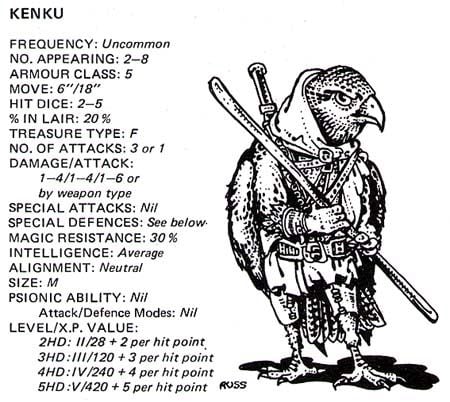
Originally appearing in the Fiend Folio, the Kenku were hawk-like humanoids who possessed magic powers and a mischevious nature. Interestingly enough, the Kenku of this era were winged, a trait that would be lost in later editions, but we’ll get to that shortly. For now, in the 1st Edition days, Kenku are mischevious creatures who habitually use their innate powers to annoy and inconvenience humans. Natural tricksters and thieves, an average Kenku has the same abilities as a 4th-level Thief, and comes armed with either a quarter staff or katana (though it is called a samurai sword in this edition). The attack stats listed above (1d4/1d4/1d6) are for two fists and a vicious bite attack.
Their power was linked to their hit dice. A 2HD Kenku had no inborn magical powers (save the magic resistance) but did possess thieving abilities and the ability to pass as a human for the most part. Kenku with 3HD had access to a single spell and can change their shape once every 30 days, though their transformation only lasted 7 days before they’d revert to their original form. Naturally this lead Kenku into mischief–their entry even specifies that many Kenku usually would assume the form of a god and accept offering from credulous worshippers. Keep that in mind as we go.
4HD Kenku have additional spells and can become Invisible at will. 5HD gain access to second level spells, and can call lightning as an innate ability, making them among the most powerful of the creatures. Though there are rumored to be even more powerful Kenku who possess even more magical powers–though these are unconfirmed rumors only hinted at in their entries.
But–these Kenku had magical powers and could fly and even communicate with each other telepathically. They never spoke–and to other humans they’d just offer nonverbal advice which would usually lead them to ruin, or at least danger–with only about a 5% chance of their advice being actually helpful.
The Kenku of 2nd Edition get an artwork upgrade, coming at you in glorious technicolor. Curiously, their description even reflects this, with the 2nd Edition Kenku described as having feathers that are predominately brown with white underfeathers an face markings, and eyes that are a brilliant yellow. Aside from this update to their descriptions, they remain largely unchanged from 1st to 2nd edition. As before they have powers based on the number of hit dice they have, though their society gets an interesting expanded detail. Kenku of this edition relied mostly on kidnapping wealthy humanoids and ransoming them back as a source of revenue.
And of course, continuing the 2nd Edition trend of assigning a monetary value to everything about a monster–their eggs could commonly be sold for 250gp, and their hatchlings are even listed as having a price, though the monster manual does at least caution that this is literal slavery and that Kenku will rescue any captives they find and stop at nothing to avenge slain kenku.
3rd Edition Kenku don’t appear until the Monster Manual 2, and there they’ve undergone a fairly significant transformation from edition to edition. Now instead of the proud hawklike humanoids who had wings and human-like arms (and bird legs, let’s not forget), they are more ravenesque in nature. Ghastly, grim, and ancient, like something that might step out of the night’s plutonian shore.
Most importantly, they lack wings and no longer possess the ability to fly. They do, however, speak–having gained the ability to speak Common and their own Kenku language. Kenku retain the trait of being natural born thieves, with Rogue as a favored class and a bonus to Hide and Move Silently checks (when those were separate skills). They do gain one of their signature abilities here though–the ability to perfectly mimic any familiar sounds, voices, and accents it can hear.
No reason is offered for their transformation–and indeed most Kenku are still regarded as secretive gangs who work together. And they work exceptionally well with each other, gaining extra bonuses on cooperative actions, including a +3 bonus from aiding another and a + 4 bonus from flanking. Whatever changed them, forced them to band together.
This also marks the first time that Kenku are offered as an official player race. They come with ability scores, the extra bonus from flanking/aid another, and the ability to mimic whatever they want as well as racial bonuses to hide and move silently. Many a Kenku rogue was seen in 3rd edition–and with their mimicry, you’d see a decent number of assassins as well.
Before you go rushing off to tell me I’ve repeated a picture–that’s the work of 4th Edition, and not I! The same artwork from 3rd to 4th is used, which is alright–the Kenku didn’t really change too much from 1st to 2nd, in terms of appearance. So it seems to be a significant art rework every two editions or so.
Kenku are an exemplary 4th Edition monster though, coming in multiple forms with multiple modes of attack and roles in a battle. You could create an entire encounter–nay, an entire adventure using nothing but Kenku enemies and it would have fairly diverse encounters. Again, they are described as ravenlike humanoids who are opportunistic in nature and who don’t let laws or morality stand in their way.
They came in several flavors: Ruffians–minions who mostly flit around the battlefield trying to help make sure their more powerful allies can hit; Warriors who are incredibly mobile; Ringleaders who can help direct their flock around the battlefield, allowing them to shift and attack a target for extra damage, even knocking them prone so the Kenku’s flock can be more accurate.
You’d also see Kenku Sneaks, who strike from the shadows for massive damage, either hurling daggers from the safety of their flock, or ambushing targets with sneak attack damage. Kenku Wing Mages, who don’t actually possess wings–but can use their magic to gain fly (temporarily), though they still don’t seem to be able to fly as before. And finally, the Kenku Assassin, who is a swift and deadly attacker that can slow and poison and spring on unsuspecting enemies.
All of these are designed to work with one another. Their flock effect abilities and mimicry are carried over from the previous edition–you get a sense of a very close-knit, secretive group about whom little is known. Which takes us into 5th Edition.
In 5th Edition, they are decidedly more ravenlike. They are much more bird than human, and I adore just how birdlike their heads are (more on this in a moment). They retain many of the aspects of the original Kenku–they are natural rogues, though here this means they’ve skilled at Stealth and Deception, and have advantage against any creature it has surprised. And they have that iconic mimicry that Kenku have had since 3rd Edition. But what’s interesting is the lore.
Kenku are widely renowned as vagabonds and greedy wanderers…but there’s rumors of what they once were. Their talons are clearly made for grasping trees and they cover their forms so as to hide the fact that they once had wings. The entry reads:
Once, the Kenku held wing in their wings, embracing the gusty sky and singing the sweet language of birdsong. Serving a master whose identity is now lost to their memory, the kenku coveted the glittering baubles of his household, and long to speak so that they could cajole and swindle others out of such treasures.
Advertisement
Of course that’s only one version of the story–but in the story they were caught and stripped of their wings and ability to speak–instead they can only mimic the sounds of whatever they hear. And that’s the story as they appear in the monster manual–but then in Volo’s Guide, the Kenku get a closer look.
And much better art.
As in 3rd edition, here Kenku are official player races once again. And their story is given more attention. They go from being sinister vagabonds to a fallen species. They once served a mysterious extraplanar power–perhaps Grazz’t or one of the Wind Dukes of Aaqa–but whoever they ultimately served is no longer remembered. They are said to have betrayed them, but then were caught and thrice-cursed. They were stripped of their wings–the wings they once had withered and fell away. Their creativity was stolen from their souls–and their voices (which once were capable of speech) were taken from them. And then they’ve been unleashed upon the world, where the people of the Material Plane seldom welcome them.
Above all else, these Kenku wish to regain their ability to fly–every last one of them is described as being born with a desire to take to the air. They gather in flocks, they steal ideas and baubles from others, and endure. They remind me of grackles, in a way, adapting to the refuse of society in order to survive–and even thrive.
But we get this interesting continuity throughout the editions. The 1st Edition Kenku are clearly the Kenku of old. They posed as gods. They misled travelers. They prized gold above all else and were capricious–and then, between 2nd and 3rd edition, they were cursed. By the gods. By demon lords. By the fickle finger of fate–whatever the case, the curses that govern the lives of each Kenku in 5th edition can be seen writ across the monster manual entries from 3rd edition onwards.
It’s the story of a tragic fall that takes them from their hawklike mischief in 1st edition to raven (or grackle or other bird)-like grimness in 5th.
But that’s not why people love them. People understand that bird wizards are amazing. And sometimes you’ll see other birds swapped in, like this finch friend up there.
Well there you have it, a monster that spans editions and has change rather significantly from beginning to now. How many more birdpeople can you name?

